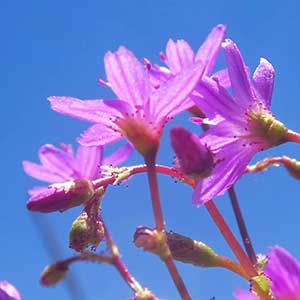Lewisia leeana
Lewisia pygmaea
many flower lewisia, quill-leaf lewisia
alpine lewisia, dwarf lewisia, least, pigmy bitter root, pygmy bitterroot
gradually ramified distally.
gradually ramified distally or shortly fusiform, rarely subnapiform.
spreading or suberect, 8–20 cm.
± prostrate or suberect, becoming reflexed in fruit, 1–6 cm.
basal leaves evergreen, sessile, blade linear, ± terete, 1.5–6 cm, margins entire, apex obtuse;
cauline leaves alternate, intergrading with bracts, blade narrowly lanceolate, 5 mm, margins entire, apex acute.
basal leaves withering at or soon after anthesis, ± sessile or gradually tapered to long petiole, blade linear to linear-oblanceolate, ± flattened, 3–9 cm, margins entire, apex acute to obtuse;
cauline leaves absent.
paniculate cymes, 50–70(–100)-flowered;
bracts several, alternate proximally, 2 at each flowering node distally, ovate to narrowly lanceolate, 2–5 mm, margins glandular-toothed, apex acute.
2–4(–7)-flowered in racemose cymes or with flowers borne singly;
bracts 2, opposite, plus 1 subtending each successive flower if more than 1 flower, linear-oblong, linear-lanceolate, or lanceolate, (2–)4–10 mm, margins glandular-toothed, sometimes eglandular-toothed, apex acute.
pedicellate, not disarticulate in fruit;
sepals 2, suborbiculate, 1–4 mm, herbaceous at anthesis, margins glandular-toothed, apex truncate;
petals 5–8, magenta, lavender, or white with or without magenta veins, obovate, 5–7 mm;
stamens 4–8;
stigmas 2;
pedicel 3–15 mm.
pedicellate, not disarticulate in fruit, 1.5–2 cm diam.;
sepals 2, suborbiculate, broadly ovate, or obovate, 2–6 mm, herbaceous at anthesis, margins usually glandular-toothed, sometimes eglandular-toothed or rarely ± entire, apex usually truncate, sometimes rounded, obtuse, subacute, or apiculate;
petals 5–9, white, pink, or magenta, sometimes green at base, narrowly oblong, elliptic, or oblanceolate, 4–10 mm;
stamens (4–)5–8;
stigmas 3–6;
pedicel 2–5(–10) mm.
4–5 mm.
4–5 mm.
1–2, 2–2.5 mm, shiny, smooth.
15–24, 1–2 mm, shiny, smooth.
= 14.
= ca. 66.
Lewisia leeana
Lewisia pygmaea
Lewisia leeana is known only from northwestern California and southwesternmost Oregon, and a disjunct population in Fresno County, California. As discussed by B. Mathew (1989b), Lewisia ×whiteae Purdy (California) is a natural, constantly recurring hybrid between L. leeana and L. cotyledon. In their narrowly spatulate leaves, the hybrids resemble L. columbiana out of range (cf. L. T. Dempster 1993); the flowers are reportedly more deeply colored.
(Discussion copyrighted by Flora of North America; reprinted with permission.)
The circumscription and diagnosis of Lewisia pygmaea is problematic because of morphologic variability, intermediacy, and/or hybridization with L. nevadensis (see L. T. Dempster 1990). In the range of typical forms of L. nevadensis (see discussion under 11. L. nevadensis), one or more forms of L. pygmaea will also occur, but at higher elevations. Segregates of L. pygmaea recognized elsewhere as species include L. glandulosa, which occurs in rocky substrates above 3000 m in the central and southern Sierra Nevada and is characterized by elongate, sinuous taproots (L. T. Dempster 1990); and L. sierrae, which occurs in moist flats above 2400 m in the central Sierra Nevada and includes diminutive plants with irregularly eglandular-toothed (occasionally entire) sepals (B. Mathew 1989b). Dempster postulated that the variable and widely distributed L. pygmaea represents a hybrid species derived from L. nevadensis and L. glandulosa.
(Discussion copyrighted by Flora of North America; reprinted with permission.)


